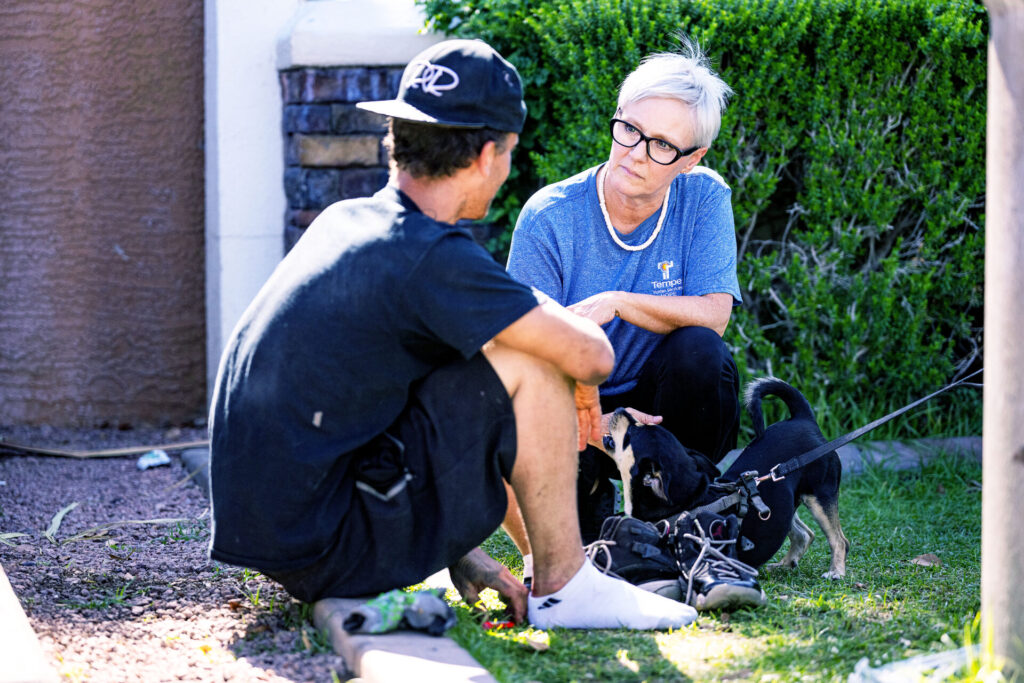The recent dismantling of two large encampments of people without housing, including one in Tempe’s Salt River bed, may have resulted in the scattering of hundreds of individuals to other parts of the Valley. But officials in Tempe and in Phoenix, ordered by an Arizona judge to close a crowded camp near the state Capitol earlier this month, are working to improve emergency shelters, expand services to help the unsheltered transition into permanent housing, and provide vital health screenings and referrals for employment and other basic needs.
Such moves are important because Arizona has one of the worst homeless crises in the country. Since the start of the COVID-19 pandemic, the state recorded a 23 percent jump in people experiencing homelessness, according to the 2023 Point-in-Time count reported by the U.S. Department of Housing and Urban development.
“The pandemic was just extra challenging — for some people it was the straw that broke the camel’s back,” said Heather Ross, a professor in ASU’s Edson College of Nursing and Health Innovation, who teaches health equity and social justice. “But for so many more who were one paycheck away … well, it proved the point.”

ASU research at CASS
1. Ross is conducting research at a large emergency facility in Phoenix operated by CASS (Central Arizona Shelter Services) on the needs of vulnerable people who, for whatever reason, are unsheltered. With Natalie Florence, an architect and ASU doctoral candidate, Ross wrote a recent article advocating for privacy and quiet for those in shelters.
“It doesn’t take a rocket scientist to imagine that, sleeping in a shelter with dozens and dozens of people trying to share a bunk-bed situation, in a congregant setting, you won’t get a good night’s sleep,” she said. “Night after night, this sets you up to have less resilience and less ability to do what you need to overcome the challenges of homelessness — finding housing, finding a job, doing other things.”
CASS has created healthier sleep spaces, such as dorms that remain dark, quiet and cool, and the ASU researchers are recommending other small changes, including subdividing the day room into more private spaces for online tele-health appointments, counseling and job interviews. Their proposed solutions to long-term impacts of overcrowding include sanitation amenities — laundry facilities, more bathrooms, even reliable trash removal to reduce the spread of infection and pests.
“We can make small changes that help support people in exiting homelessness successfully, of going from a shelter to stable housing,” Ross said. CASS also has started screening older adults entering its shelter for mild cognitive impairment and dementia, Ross said, after public safety officials reported more of them exhibiting potential symptoms. “We are seeing really startling numbers of positive screenings,” she said. “That may be because most shelters don’t screen and now CASS is, but we need to validate, is there something going on in Phoenix? Or are mild cognitive impairment or dementia risk factors for homelessness?”
Tempe closes river bed, expands homeless outreach
On Aug. 31, Tempe closed an encampment in the Salt River bed over safety concerns, exacerbated in part by an especially wet spring. Rainfall raised water levels in Tempe Town Lake and necessitated flow releases into the riverbed. Additionally, calls for police and fire assistance to the area, which had access issues, had risen over the years, and hypodermic needles, chemicals and human waste created hazards.
The city’s homeless and crisis response teams, along with its nonprofit partners, met with 75 people living in the river bed, and 50 of them accepted relocation assistance, said Tim Burch, Tempe’s Community Health and Human Services director. “Our primary goal was the life and safety of individuals there,” Burch said. It isn’t known where those not accepting services landed, nor is there data on where people living in the large Phoenix encampment, known as “The Zone,” went.
However, Tempe’s Point-in-Time street and shelter counts have showed decreases in the homeless population, from 515 people in August 2022 to 355 last June. Tempe offers “noncongregate,” or private, spaces in its homeless shelters; a 40-room motel that it owns; and 40 rented rooms in a different hotel. Both are near capacity, as are most shelters in the Valley. The city also refers unsheltered people to its partners, among them A New Leaf and Tempe Community Action Agency.
The city also refers them for “whole person” health screening to partners such as Circle the City. Recent expansions of Tempe’s HOPE (Homeless Outreach Prevention Effort) team, partnerships with crisis responders, data analysis, and opportunities for community volunteers are helping, Burch said. “Our HOPE team has 16 people working shifts seven days a week, 24 hours a day, meeting people wherever they are,” he said. “It’s the first point of compassionate contact that many on the street will get.” Tempe also launched a new public dashboard providing data about its homeless outreach progress, and is recruiting more community volunteers.
For example, they can work alongside the HOPE team in the field, people without homes to services, or participate in the Point-in-Time homeless counts in January (email volunteerHOPE@tempe.gov) for info. Local businesses can help qualified people in need to become self-sufficient by providing jobs through the Tempe Works program.
“Housing is the first step, but they also need employment,” Burch said. “We call it real change, not spare change.”


